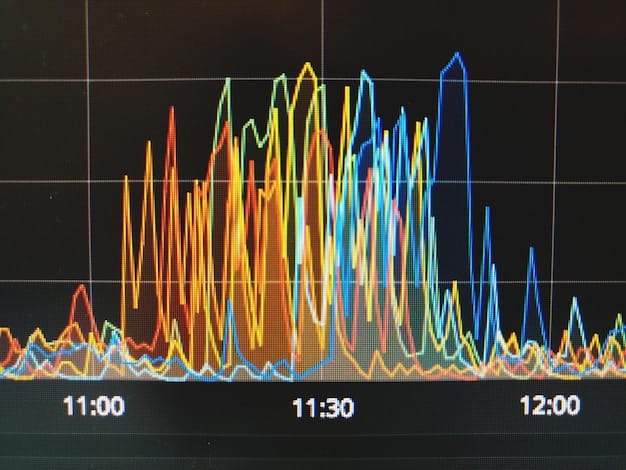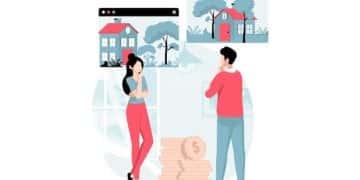Federal Reserve Rate Hikes: Impact on Personal Loan Rates

The Impact of the Federal Reserve’s Projected Interest Rate Hikes on Personal Loan Rates is significant, potentially leading to higher borrowing costs for consumers seeking personal loans, influencing affordability and demand in the personal finance market.
Navigating the landscape of personal finance can feel like a tightrope walk, especially when external factors like Federal Reserve interest rate decisions come into play. Understanding the impact of the Federal Reserve’s projected interest rate hikes on personal loan rates is crucial for anyone considering borrowing money for personal needs.
Understanding the Federal Reserve’s Role
The Federal Reserve, often simply called the Fed, plays a vital role in managing the US economy. Its decisions have far-reaching consequences, impacting everything from inflation to unemployment to, yes, even personal loan rates. Let’s break down its function in simple terms.
What Does the Federal Reserve Do?
The Federal Reserve is the central bank of the United States. Its primary mission is to promote a healthy economy by controlling monetary policy.
- Controlling Inflation: The Fed aims to keep inflation at a stable and predictable level, typically around 2%.
- Promoting Full Employment: The Fed strives to maximize employment levels, ensuring that as many people as possible have jobs.
- Maintaining Financial System Stability: The Fed works to ensure the stability of the financial system and prevent banking crises.
- Influencing Interest Rates: One of the Fed’s key tools is influencing interest rates, which affects borrowing costs for individuals and businesses.
The Fed influences interest rates primarily through the federal funds rate, which is the rate at which banks lend reserves to each other overnight. When the Fed raises the federal funds rate, it becomes more expensive for banks to borrow money. These increased costs are often passed on to consumers in the form of higher interest rates on loans, including personal loans. Conversely, when the Fed lowers the federal funds rate, borrowing becomes cheaper, potentially leading to lower interest rates for consumers.
In summary, the Federal Reserve manages monetary policy by monitoring inflation and employment, and it uses the federal funds rate to influence borrowing costs and promote a stable economic environment. Understanding its role is crucial to understanding shifts in personal loan interest rates.

How Federal Reserve Rate Hikes Affect Interest Rates
When the Federal Reserve increases interest rates, the repercussions are felt throughout the economy. One immediate impact is on the cost of borrowing money. Here’s a closer look at how these rate hikes influence interest rates.
The Ripple Effect on Borrowing Costs
When the Fed raises the federal funds rate, it sets off a chain reaction that affects the interest rates that banks charge their customers. Banks themselves have to pay more to borrow money, so they pass those costs on to consumers and businesses. Let’s explore the specific mechanisms that drive this ripple effect and examine historical instances to understand how these changes can affect borrowing costs.
- Increased Lending Rates: As the cost of borrowing increases for banks, they, in turn, raise the interest rates they charge on loans, including personal loans, mortgages, and credit cards.
- Impact on Variable Rates: Variable-rate loans, where the interest rate fluctuates with a benchmark rate, are particularly sensitive to Fed rate hikes, leading to immediate increases in monthly payments.
- Effect on Fixed Rates: Though fixed-rate loans are not immediately affected, new fixed-rate loans will typically be offered at higher interest rates to reflect the changes in the broader interest rate environment.
The Fed rate hikes impact interest rates through increased costs for banks, which are passed to consumers via higher loan rates, affecting both variable and fixed-rate loans. This ripple effect impacts the affordability of borrowing.
Impact on Personal Loan Rates Specifically
Personal loans are a popular option for individuals looking to finance various needs, from consolidating debt to covering unexpected expenses. However, the attractiveness of these loans can change significantly when the Federal Reserve hikes interest rates.”
Why Personal Loans Are Sensitive
Personal loan rates are often closely tied to benchmark interest rates like the prime rate, which typically moves in tandem with the federal funds rate. As the Fed raises rates, personal loan rates tend to follow suit. This means that the cost of borrowing money through personal loans can increase, potentially affecting the affordability and overall demand for these loans.”
Moreover, lenders may tighten their lending standards in response to rising rates, making it more difficult for some borrowers to qualify for personal loans. Here are some ways in which the interest rates on personal loans are impacted:
- Increased APRs: The Annual Percentage Rate (APR) on personal loans, which includes the interest rate and any fees, can increase, making loans more expensive over their terms.
- Higher Monthly Payments: Borrowers may face higher monthly payments, reducing their disposable income and straining their budgets.
- Reduced Loan Amounts: Some lenders may reduce the loan amounts they are willing to offer, forcing borrowers to seek alternative sources of financing.
Several historical examples show how personal loan rates have responded to Federal Reserve rate hikes. For example, during periods of aggressive rate increases in the past, personal loan APRs experienced notable rises, reflecting the direct impact of the Fed’s monetary policy on consumer borrowing costs.

Strategies for Borrowers During Rate Hike Periods
In times when the Federal Reserve raises interest rates, it’s important for borrowers to adjust their strategies to navigate the changing financial landscape. Here are some strategies that can help borrowers make informed decisions and mitigate the impact of rising rates.
Navigating the Financial Landscape
Before taking out a personal loan, it’s essential to assess your financial situation and borrowing needs realistically. Calculate how much you can comfortably afford to repay each month, considering your other financial obligations and prioritize essential expenses to ensure you can manage your debt effectively.
- Shop Around for the Best Rates: Compare offers from multiple lenders to find the most favorable interest rates and terms, as rates can vary significantly between different financial institutions.
- Consider a Secured Loan: If possible, consider a secured personal loan, which is backed by collateral such as a car or savings account. Secured loans often come with lower interest rates compared to unsecured loans. However, be aware that you risk losing your collateral if you default on the loan.
- Improve Your Credit Score: A higher credit score can help you qualify for lower interest rates and better loan terms. Take steps to improve your credit score by paying bills on time, reducing outstanding debt, and avoiding new credit applications unless necessary.
In summary, borrowers should adapt to rising interest rates by thoroughly assessing their needs, exploring various loan options, and enhancing their creditworthiness, optimizing their borrowing experience during challenging economic times.
Long-Term Financial Planning Considerations
The Federal Reserve’s interest rate hikes not only affect personal loan rates but also have broader implications for long-term financial planning. Understanding these implications and adjusting your financial strategies accordingly can help you achieve your long-term financial goals.”
Impact on Savings and Investments
Higher interest rates can affect savings accounts, investment returns, and retirement planning. When interest rates rise, savings accounts and certificates of deposit (CDs) may offer higher yields, providing an incentive to save more. Conversely, rising rates can impact the stock market and bond yields, leading to fluctuations in investment portfolios. To weather potential market volatility, consider diversifying your investments across different asset classes and adopting a long-term investment horizon, mitigating the effects of short-term market movements.”
- Adjusting Investment Strategies: Consider reevaluating your investment portfolio to ensure it aligns with your risk tolerance and financial goals in a rising-rate environment.
- Evaluate Retirement Planning: Adjust your retirement planning assumptions and projections to account for changes in interest rates and investment returns, ensuring you stay on track to meet your retirement goals.
- Budgeting and Savings Habits: Revise your budget to account for potential increases in borrowing costs and adjust your savings habits accordingly. Consider cutting non-essential expenses and allocating more funds to savings and debt repayment.
Adapting long-term financial plans by diversifying investments, reassessing retirement assumptions, and revising budgets can ensure stability and future financial success amidst changing economic conditions.
Future Projections and Economic Outlook
Staying informed about future projections and the overall economic outlook can help you anticipate and prepare for further interest rate changes. Economic forecasts from reputable sources can provide insights into potential future rate hikes and help you make informed financial decisions.
Staying Informed
Following the announcements and statements made by the Federal Reserve can offer clues about the direction of monetary policy. Track economic indicators such as inflation rates, employment numbers, and GDP growth figures to gauge the overall health of the economy. Monitor financial news and analysis from credible sources to stay abreast of the latest developments and expert opinions on the economic outlook.
Future economic forecasts indicate expectations for GDP, inflation, and unemployment, which significantly impact financial decisions. These forecasts are crucial for economic planning, impacting both policy and individual financial strategies.”
- Consulting Financial Professionals: Consider seeking advice from financial advisors who can help you assess your financial situation, develop personalized strategies, and navigate the complexities of a changing economic environment.
- Diversifying Information Sources: Rely on multiple credible sources for financial information to ensure a well-rounded understanding of the economic landscape and avoid being swayed by biased or inaccurate information.
Staying informed through diverse sources, consulting professionals, and following authoritative statements allows proactive financial planning and resilience against market fluctuations.
| Key Point | Brief Description |
|---|---|
| 💰 Rate Hike Impact | Increased borrowing costs due to Fed rate hikes. |
| 📊 Strategies | Shop around, consider secured loans, improve credit score. |
| 📈 Long-Term Planning | Adjust investments, retirement plans, and savings habits. |
| 📰 Staying Informed | Follow Fed announcements, track economic indicators, seek advice. |
Frequently Asked Questions
What is the Federal Reserve’s role in influencing interest rates?
▼
The Federal Reserve influences interest rates by setting the federal funds rate, which affects the cost for banks to borrow money.
What happens to personal loan rates when the Federal Reserve raises interest rates?
▼
When the Federal Reserve raises rates, personal loan rates typically increase as well, making borrowing more expensive.
What can borrowers do to mitigate the impact of rising personal loan rates?
▼
Borrowers can shop around for the best rates, consider secured loans, and improve their credit scores to qualify for lower rates.
How do Federal Reserve rate hikes affect long-term financial planning?
▼
Rate hikes can affect savings accounts, investment returns, and retirement planning. It’s important to adjust investment strategies and savings habits.





